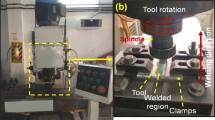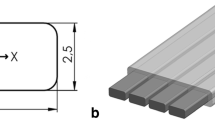Abstract
The shape memory alloys present unusual thermo-mechanical properties. The most important of them are pseudo-elasticity and memory effect. The paper investigates this behaviour for the Ni-Ti wires under static (v < 50 mm/s) and dynamic conditions (v > 50 mm/s) at different temperatures. Ni-Ti actuator and pseudoelastic wires with diameter between 0.1 mm to 0.5 mm are being tested. For dynamic investigation a new testing plant able to satisfy the testing conditions is created. This new testing plant is still under development and the reported results originate from the first tests on this new machine. The new device is designed to reach speeds higher than 50 mm/s. These speeds can be achieved using a drop weight which will hit a bottom plate and by this the kinetic energy is transferred to the sample. Because the weight is dropped, the stroke for the sample is measured in two points. The force of this impact will be in-line measured and, if the sample will be electrically activated during this test, it is also possible to log the electrical voltage. To widen the application range of the shape memory alloys it is necessary to study their behaviour in the dynamic region. With the new testing facility, it is expected to test the damping properties of SMA wires. In that case, these results can generate the basis for finding new applications for shape memory alloys especially in the automotive safety industry.
Similar content being viewed by others

References
Barnes, B., Brei, D. and Luntz, J. (2006). Panel deplyment using ultrafast SMA latches. ASME 2006 Int. Mechanical Engineering Cong. and Exposition, Chicago.
Casciati, S. and Hamdaoui, K. (2010), Experimental studies on the fatigue life of shape memory alloy bars. Smart Structure and Systems, 6, 73–85.
Chang, B. C., Shaw, J. A. and Iadicola, M. A. (2006). Thermodynamics of shape memory alloy wire: Modeling, experiments and application. Continuum Mechanics and Termodynamics, 18, 83–118.
Craciunescu, C. and Wutting, M. (2000). Extraordinary damping of Ni-Ti double layer films. Thin Solid Films, 379, 173–175.
Dazhi, Y. (2000). Shape memory alloy and smart hybrid composites advanced materials for the 21st century. Material and Design, 21, 503–505.
Dolce, M. and Cardone, D. (2011). Mechanichal behaviour of shape memory alloys for seismic applications 2. Austenite NiTi wires subjected to tension. Int. J. Mechanical Sciences, 43/11, 2657–2677.
Doare, O., Sbarra, A., Touze, C., Moussa, O. M. and Moumni, Z. (2012). Experimental analysis of the quasistatic and dynamic torsional behaviour of shape memory alloys. Int. J. Solids and Structures, 49/1, 32–42.
Gheorghita, V., Gümpel, P., Strittmatter, J., Chiru, A., Heitz, T. and Senn, M. (2013). Using shape memory alloys in automotive safety systems. Proc. FISITA 2012 World Automotive Cong., Lecture Notes in Electrical Engineering, 195, 909–917.
Gümpel, P., Gläser, S., Jost, N., Mertmann, M., Seitz, N. and Strittmatter, J. (2004a). Formgedächtnislegierungen — Einsatzmöglichkeiten in Maschinenbau, Medizintechnik und Aktuatorik. Expert-Verlag. Renningen.
Gümpel, P., Radu, I. S., Bruns, A. and Strittmatter, J. (2004b). Entwicklung einer neuartigen Prüfanlage zur Prüfung von Bauelementen aus Formgedächtnismetallen, FH Konstanz, Report.
Hartl, D. J. and Lagoudas, D. C. (2007). Aerospace application of shape memory alloys. Proc. Institution of Mechanical Engineers, Part G: J. Aerospace Engineering, 221, 535–551.
Hu, J., Zhu, Y., Huang, H. and Lu, J. (2012). Recent advances in shape memory polymers: Strucure, mechanism, functionality, modeling and applications. Progress in Polymer Science, 37, 1720–1763.
Humbeeck, V. J. (2003). Damping capacity of thermoelastic martensite in shape memory alloys. J. Alloys and Compounds, 355, 58–64.
Kunze, H., Bucht, A., Pagel, K. and Zerneke, A. (2011). Leichze Formgedöchtnisactoren im Automobil. Fraunhofer Raport. Dresden.
Lagoudas, D. C. (2008). Shape Memory Alloys-Modeling and Engineering Applications. Springer. New York.
Leu, A., Aiteanu, D. and Gräser, A. (2012). High speed stereo vision based automotive collision warning system. Applied Computational Intelligence in Engineering and Information Technology, 1, 187–199.
Machado, L. G. and Savi, M. A. (2003). Medical application of shape memory alloys. Brazilian J. Medical and Biological Research, 36, 683–691.
Morgan, N. B. (2004). Medical shape memory alloy applications — The market and its products. Materials Science and Engineering, 378, 16–23.
Muntzinger, M. M., Zuther, S. and Dietmayer, K., (2009). Probability estimation for an automotive pre-crash application with short filter settling times. Intelligent Vehicles Symp., 411–416.
Otsuka, K. and Wayman, C. M. (2002). Shape Memory Materials. Press Syndicate of the University of Cabridge. Cambridge.
Sanders, B., Crowe, R. and Garcia, E. (2004). Defense advanced research projects agency — smart materials and structures demonstration program overview. J. Intelligent Material Systems and Structure, 15, 227–233.
Torra, V., Isalgue, A., Auguet, C., Carreras, G., Lovey, F. C., Soul, H. and Teriault, P. (2009). Damping in civil engineering using SMA. The fatigue behavior and stability of CuAlBe and NiTi alloys. ASM Int., 18, 738–745.
Vahidi, A. and Eskandarian, A. (2003). Research advances in intelligent collision avoidance and adaptive cruise control. IEEE Trans. Intelligent Transportation Systems, 4, 143–153.
Wolons, D., Gandhi, F. and Malovrh, B. (1998). Experimental investigation of the pseudoelastic hysteresis damping characteristics of shape memory alloy wires. J. Intelligent Material Systems and Structure, 9, 116–125.
Wu, S. K. and Lin, H. C. (2003). Damping characteristics of TiNi binary and ternary shape memory alloys. J. Alloys and Compounds, 355, 72–78.
Wang, H., Xie, L. Q., Lu, Y. X., Gao, J. G. and Zeng, Q. (2012). Research of vehicle collision warning system. Applied Mechanics and Materials, 220–223, 1602–1605.
Author information
Authors and Affiliations
Corresponding author
Rights and permissions
About this article
Cite this article
Gheorghita, V., Gümpel, P., Chiru, A. et al. Future applications of Ni-Ti alloys in automotive safety systems. Int.J Automot. Technol. 15, 469–474 (2014). https://doi.org/10.1007/s12239-014-0049-z
Received:
Revised:
Accepted:
Published:
Issue Date:
DOI: https://doi.org/10.1007/s12239-014-0049-z



